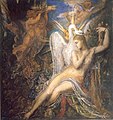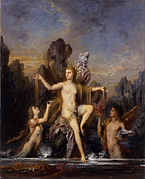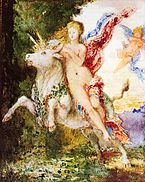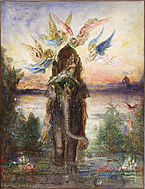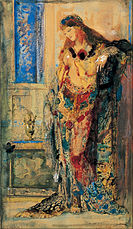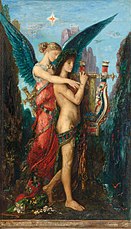Gustave Moreau | |
|---|---|
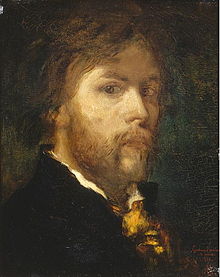 Self-portrait of Gustave Moreau, 1850 | |
| Born | 6 April 1826 |
| Died | 18 April 1898 (aged 72) Paris |
| Nationality | French |
| Education | François-Édouard Picot |
| Known for | Painting |
| Movement | Symbolism |
Gustave Moreau (French: [mɔʁo]; 6 April 1826 – 18 April 1898) was a major figure in French Symbolist painting whose main emphasis was the illustration of biblical and mythological figures. As a painter, Moreau appealed to the imaginations of some Symbolist writers and artists. He is recognized for his works that are influenced by the Italian Renaissance and exoticism. His art work was preserved in Paris at the Musée Gustave Moreau.
귀스타브 모로(Gustave Moreau, 1826년 4월 6일 ~ 1898년 4월 18일)는 프랑스의 상징주의 화가이다. 성서의 이야기나 신화를 많이 그려 이름을 날렸다. 매우 화려한 기교로 시적·환상적 표현을 하였다.
생애[편집]
귀스타브 모로는 1826년 파리에서 건축가의 아들로 태어났다. 미술 대학을 졸업하고 22세 때부터 그림을 그렸다.
1848년 이후 테오도르 샤세리오와 들라크루아의 화풍에 많은 영향을 받았다. 이 시기에 모로는 그림의 주제를 역사와 신화에서 찾기 시작하며 이는 후에 모로의 화풍을 대변하게 된다. 1857년에서 1859년까지 이탈리아를 여행하면서 신화적 주제를 모음과 동시에 그림기술을 향상시켰다. 파리로 돌아와 당시의 미술계에 유행하던 살롱 초대전에 약 20년간에 걸쳐 수시로 작품을 출품한다. 1864년 외디푸스와 스핑크스를 그려 화가로서의 명성을 얻게 된다. 이후에 그려지는 대다수의 작품은 고대 그리스신화에 나오는 인물과 일화들을 주제로 하고 있다. 모로는 의식적으로 신화를 주제로 한 그림에서 인간의 번민과 고통, 이상적인 영웅상 등을 상징적으로 표현함으로써 상징주의를 대표하는 화가로 손꼽힐 뿐만 아니라 후에 나타나는 표현주의에 결정적인 동기를 주게 된다.
1892년 파리의 예술학교의 미술과 교수로 초빙되어 마티스, 루오, 마르케 등의 화가들을 길러낸다. 특히 모로는 자상함과 형식에 구애되지 않는 교수 방법 때문에 학생들 사이에서 존경을 받은 것으로 전해진다.
1898년 파리에서 암으로 사망했다. 사망후 유언에 따라 모로가 살던 파리의 9구 로슈푸코 거리 (프랑스어: rue de la Rochefoucauld) 14번지의 집은 현재 모로 박물관(프랑스어: Musée Moreau)으로 되어 있다.
대표 작품[편집]
-----------------------------------------------------------------
요약 신화와 종교에 관한 주제를 주로 다룬 19세기 프랑스의 상징주의 화가로 주요 작품은 <환영>. 테오도르 샤세리오에게 배우면서 많은 영향을 받았는데 <오이디푸스와 스핑크스>, <살로메의 춤> 등을 통해 신화적이고 이국적인 소재와 에로티시즘에 많은 관심을 가지고 있음을 보여주었다. 그는 캔버스를 긁거나 물감을 두껍게 칠하는 등 자유분방한 양식을 실험하여 후일 추상표현주의의 선구자로 인정받게 되었으며, 마티스와 루오 등 야수파 화가들에게도 영향을 끼쳤다.
모로에게 영향을 미친 유일한 사람은 스승이자 절충화파의 화가인 테오도르 샤세리오(1819~56)였다. 바다의 여신들을 묘사한 샤세리오의 그림들은 제자인 모로에게 깊은 인상을 주었다. 그는 1853년 현대 미술전에 〈솔로몬의 아가(雅歌)에 나오는 한 장면 Scene from the Song of Songs〉·〈다리우스의 죽음 Death of Darius〉을 출품했는데, 이 두 작품은 샤세리오의 영향을 뚜렷이 보여주고 있다.
모로의 작품인 〈오이디푸스와 스핑크스 Oedipus and the Sphinx〉(1864, 미국 뉴욕 시 메트로폴리탄 미술관 소장)·〈환영(살로메의 춤) The Apparition(Dance of Salome)〉(1876, 미국 매사추세츠 주 케임브리지 포그 미술관 소장)·〈살로메의 춤 Dance of Salome〉(1876, 프랑스 파리 귀스타브 모로 미술관 소장) 등은 그가 이국적인 에로티시즘과 폭력에 차츰 많은 관심을 가지게 된 것을 보여주며, 여백 없이 빽빽한 그의 그림은 극적인 광선처리로 보석처럼 눈부신 색채가 더욱 돋보인다.
그의 마지막 작품인 〈주피터와 세멜레 Jupiter and Sémélé〉(1896, 귀스타브 모로 미술관)는 이런 경향이 절정에 다다른 작품이다. 모로의 미술은 흔히 퇴폐적이라는 평가를 받아왔으나, 캔버스를 긁거나 문지르는 등 수많은 기법을 실험했고 그림물감을 두껍게 칠한 자유분방한 양식의 비구상화들 때문에 추상 표현주의의 선구자라고 불리게 되었다. 모로는 엘리 들로네의 뒤를 이어 파리 국립미술학교 교수가 되었는데, 그의 강의는 학생들에게 대단한 인기가 있었다. 그는 마티스와 루오를 비롯한 몇몇 야수파 화가들에게 큰 영향을 미친 스승이었다. 모로는 죽을 때 자신의 집과 약 8,000여 점의 작품을 국가에 기증했는데, 이 유산으로 오늘날 파리의 귀스타브 모로 미술관이 건립되었다.
Biography
He was born in Paris, France, at 6 Rue des Saints-Peres. He came from a middle-class family. His father, Louis Jean Marie Moreau, was an architect for the city of Paris and his mother, née Adele
Pauline Desmoutier, was a musician. Moreau lived a sheltered life growing up. Having visited Italy at age 15 he began his love for art. At age 18 he entered École des Beaux-Arts to study under the guidance of François-Édouard Picot and left in 1850.[1] He then began to study art under his new mentor Théodore Chassériau, whose work strongly influenced his own. Moreau participated in the Salon for the first time in 1852.
Moreau had a 25-year personal, possibly romantic relationship, with Adelaide-Alexandrine Dureux (b.Guise, 8 November 1835), a woman whom he drew several times.[2] His first painting was a Pietà which is now located in the cathedral at Angoulême. He showed A Scene from the Song of Songs and The Death of Darius in the Salon of 1853. In 1853, he contributed Athenians with the Minotaur and Moses Putting Off his Sandals within Sight of the Promised Land to the Great Exhibition.[3]
Oedipus and the Sphinx, one of his first Symbolist paintings, was exhibited at the Salon of 1864. Moreau quickly gained a reputation for eccentricity. one commentator said Moreau's work was "like a pastiche of Mantegna created by a German student who relaxes from his painting by reading Schopenhauer."[4] The painting currently resides in the permanent collection at the New York Metropolitan Museum of Art.[5]
On 28 March 1890, Alexandrine Dureux died. Her death affected Moreau greatly, and his work after this point contained a more melancholic edge. She was buried at the same cemetery that Moreau himself would be buried.
Moreau became a professor at Paris' École des Beaux-Arts in October 1891. Among his many students were fauvist painters Henri Matisse and Georges Rouault. Jules Flandrin, Theodor Pallady and Léon Printemps also studied with Moreau. Pierre Marcel-Béronneau was one of the most brilliant students" of Moreau.[6]
Moreau died of stomach cancer and was buried at the Cimetière de Montmartre in Paris in his parent's tomb.
He was made a Chevalier de la Legion d'honneur in 1875 and was promoted to an Officier de la Legion d'honneur in 1883.
Style of art
Influence of the Italian Renaissance
The death of Chasseriau in 1856 caused Moreau in his grief to stop painting and withdraw from public life. Concerned about his condition, Moreau's parents suggested he travel to Italy again. Living in Italy from 1857 to 1859 he found a new love for art.[1] He gained inspiration from the artists of the Italian Renaissance, such as Leonardo da Vinci and Michelangelo.[7] In 1864 Moreau won a medal at the Salon with his painting Oedipus and the Sphinx, the style of which revealed his close study of the work of Mantegna and Giovanni Bellini.[8] Its firm outlines and detailed modeling are typical of the works that brought him success with critics and the public for the remainder of the decade.[8] In the 1870s, disturbed by criticism that his work had become formulaic, he stopped exhibiting for a few years while he concentrated on renewing his art. In 1876 he completed Salome Dancing before Herod, which announced a more painterly style that would characterize his later works.[8]
Exoticism
Gustave Moreau's education in classical drawing did not stop him from experimenting with different styles of art. By traveling to other countries such as Italy or Holland and reading publications Moreau was able to develop his unique form of art. The most important publications Moreau owned were The Grammar of Ornament by Owen Jones, Le costume historique by August Racinet, and Le Costume by Frederick Hottenroth.[9] All these influences led Moreau to draw not only humans, but animals and architectural monuments. Moreau started his career drawing classical art, but by incorporating exotic images he developed a mysterious and unique form of art.
Legacy[edit]
During his lifetime, Moreau produced more than 8,000 paintings, watercolors and drawings. His work influenced the next generation of Symbolists, particularly Odilon Redon and Jean Delville, a leading figure in Belgian Symbolism in the early part of the twentieth century. Many of Moreau's works are on display in Paris' Musée national Gustave Moreau at 14 rue de la Rochefoucauld (9th arrondissement). The museum is in his former workshop, and began operation in 1903. André Breton famously used to "haunt" the museum and regarded Moreau as a precursor of Surrealism.
The Japanese artist Yoshitaka Amano, known for works such as Final Fantasy, Angel's Egg, and Vampire Hunter D, was inspired by Moreau's style. Amano said in an interview that when he was first experimenting with styles to try to find his own, he would try to mimic the works of Moreau.[10]
Gallery
- Gustave Moreau's works
Jason and Medea (1865)
(Musée d'Orsay)Orpheus (1865)
(Musée d'Orsay)Venus Rising from the Sea (1866) (Israel Museum)
Europa and the Bull (1869)
Salomé (1876)
(Musée Moreau)The Apparition (1876)
(Musée d'Orsay)Jacob and the Angel (1878)
(Fogg Museum)Galatée (1880)
(Musée d'Orsay)The Sacred Elephant (Péri) (1885)
(NMWA Tokyo)The Toilette (1885–90)
(Bridgestone Museum of Art)Song of Songs (Cantique des Cantiques) (1893)
(Ohara Museum of Art)Jupiter and Semele (1894–95)
(Musée Moreau)
See also
'♣ 미술(美術) 마당 ♣ > - 화가[畵家]' 카테고리의 다른 글
| [프랑스계 영국]James Alexander Walker (0) | 2020.02.01 |
|---|---|
| [프링스]Louis Gauffier (0) | 2020.01.16 |
| [네델란드]Jacob van Ruisdael[야콥 반 로이스달] (0) | 2020.01.12 |
| [프랑스] 장 앙투앙 와토(바토)[Jean-Antoine Watteau] (0) | 2020.01.11 |
| [네델란드]프란츠 할스[Frans Hals] (0) | 2020.01.09 |


